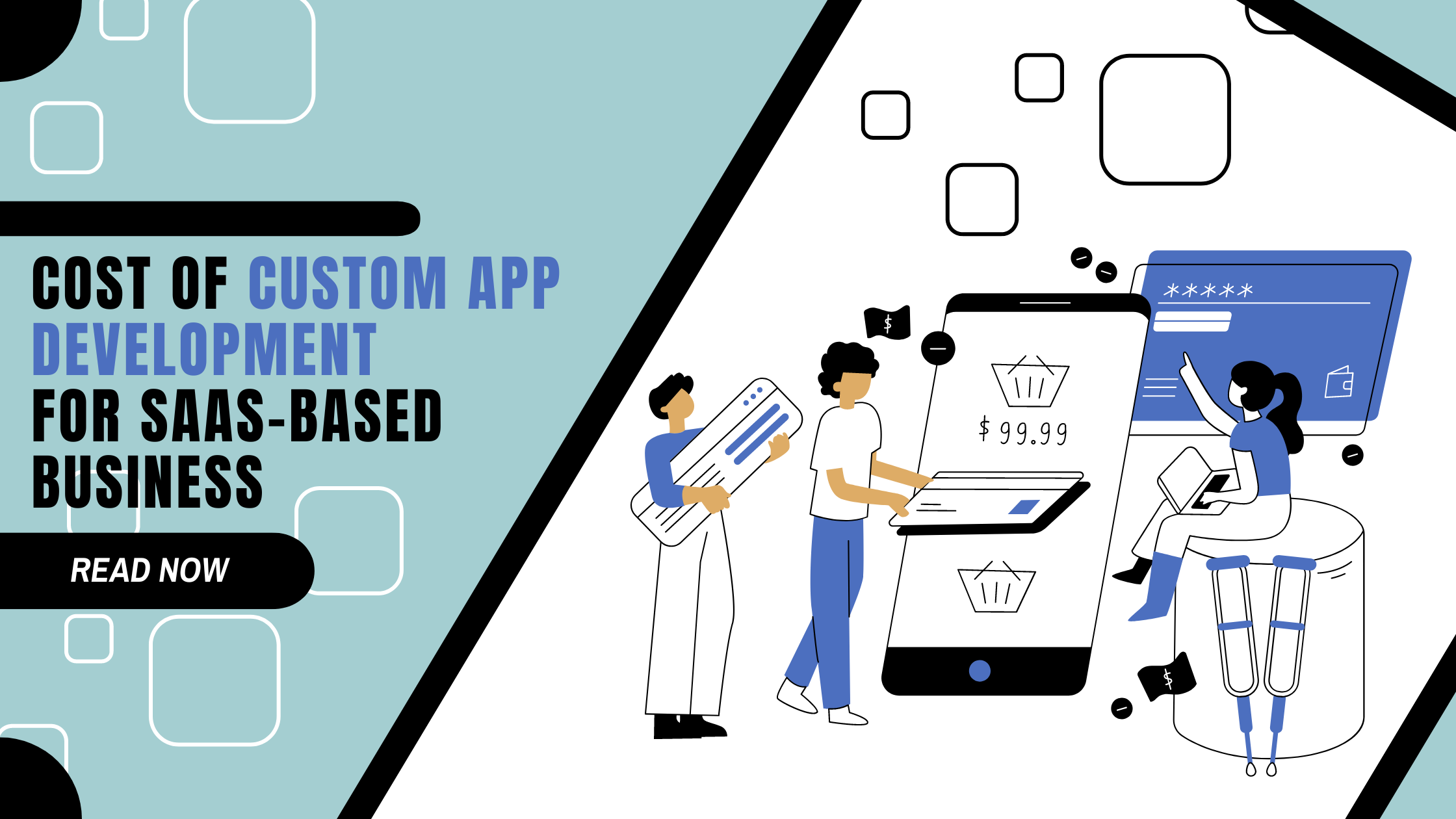Software as a service (SaaS) has become a popular business model for companies looking to provide their customers with convenient, cost-effective, and scalable solutions. There are many successful SaaS-based businesses in the market that are making waves in the industries. However, building a custom SaaS application can be a complex and expensive endeavor. In this article, we will explore various factors that can impact the cost of custom SaaS app development. We will also provide a detailed list of hidden costs and how to reduce them without compromising the quality of the app.
FACTORS AFFECTING THE COST OF CUSTOM SAAS APP DEVELOPMENT
The Complexity of the Application
One of the first things that can affect the overall cost of app development is complex functions and designs. Complex apps can take more time, effort, and resources to build. It also includes the level of customization, functionalities, integration, and technology stack.
A complex SaaS app requires a high degree of expertise and specialized knowledge in different areas, such as software architecture, database design, user interface design, and the entirety of software development. It will also affect the cost of maintenance, scalability, performance, and support. The cost of a complex app is higher than a simple or basic app.
Features and Functionality Required
Features and functionalities are the core elements of every SaaS app. It provides specific functions and the capability to solve issues for the user. Complex features will require more time and effort, which will add to the cost. Most features in SaaS apps are basic functionalities to advance features that provide a competitive edge in the market.
For example, a project management SaaS application will require features like task management, time tracking, reporting, and more. Similarly, for accounting software, we need to add features like invoicing, billing, expense tracking, and more. That’s why we need to prioritize features based on user needs and business goals.
Technology Stack and Development Approach
Technology stacks play a vital role in the overall cost of app development. The technology stack includes programing language, database, server infrastructure, tools, framework, and methodology. When we use a popular programming language or framework with a large community, it will lower the cost because of resources and support.
By choosing the right methodology, we can reduce the cost of app development too. For example, if we choose an agile methodology that will prioritize development and collaboration. This will reduce the cost by ensuring that the development team focuses on more critical features and functionality first. By selecting the right technology stack and development approach, we can lower the cost and streamline the work process.
Design and User Experience
Design and UX play a critical role in attracting and retaining users by using visual and interactive aspects of the app. App designs include parameters like color, typography, layout, and graphics in UI. We need to create a visually appealing design that is consistent with the brand identity. We also need to choose a design that separates our app from the competition and provides a better experience for the user.
While UI is all about looks, UX is for the overall experience that users have while using the app. This is an important part of app development as we need to provide a seamless experience to the user. UX design includes interactivity, navigation, responsiveness, and a learning curve. Design and UX are an important part of SaaS app development, and it requires expertise in interface design.
Type of SaaS application
Software as a service caters to different industries’ use cases and user needs. There are various types of SaaS applications in the market, and it can affect the total cost of app development. Here are some of the common SaaS-type apps.
-
CRM
Customer relationship management applications are designed to help businesses manage customer relationships and interactions. This type of SaaS app has features like contact management, sales pipeline management, marketing automation, and customer support.
-
HRM
Human resource management helps with the human resource department of a business. This type of app has functionalities like employee information management, payroll, benefits, and performance evaluation.
-
Accounting and Finance
Accounting and finance are one of the most important departments in any business, and this type of SaaS app solved their issue by providing important features. Such as tax management, financial reporting, expense management, and more.
-
Project Management
Every business needs a project management tool to expedite and streamline its work process. It has features like task management, meeting, collaboration, and more.
-
ERP
Enterprise resource planning provides features like inventory management, production planning, order management, and more. These types of apps are necessary for businesses that are in finance, manufacturing, or supply chain.
HIDDEN COST OF CUSTOM APP DEVELOPMENT FOR SAAS BASED BUSINESS
Ongoing Maintenance and Updates
Maintenance and updates are an important part of every SaaS app, and we need to take them into consideration for the cost of app development. Once we launch the app, it requires continuous maintenance and update to function and stays secure and up to date. This includes activities like bug fixes, security patches, feature enhancement, performance optimization, and more.
The cost of ongoing maintenance and update can vary depending on the complexity of the application. However, most businesses spend around 15% to 20% of their initial budget on it. If we neglect this, it can lead to several risks, such as security breaches, performance issues, outdated features, and more. Also, we need to remember that our customer’s business is also depending upon our app, which might get affected gravely.
Integration
Most SaaS apps need to integrate with other systems and platforms to add new features and functionality to the app. It depends on the scope of integration, how many systems we need to integrate with, and the customization we require. Some integration requires custom APIs or connectors, while others can rely on standard APIs or third-party integration.
We need to include integration in the overall cost as it will require the expertise of an experienced developer, testing teams, and more. It will improve data management and analysis, efficiency, collaboration, and communication.
Marketing
Many businesses make the mistake of thinking their SaaS app will sell itself and do not count the expense of marketing and promotional activities. Marketing should be considered an ongoing activity rather than a one-time cost. We need to include marketing with app development as it will ensure that the app meets the needs and preferences of the targeted audience.
The cost of marketing depends on the competition in the market, targeted audience, marketing channels, and total budget. Businesses that invest heavily in marketing will reap the benefit early on as they include it with the development.
App Publishing Cost
Once the development process is over, we need to publish or deploy it on a hosting platform where users can access the app. Some of the most common cloud-based hosting platforms are amazon web services, Google cloud platform, and Microsoft Azure. We can also choose other dedicated hosting providers or managed hosting providers. The cost of hosting depends on factors like the number of users, amount of data processed, and level of security.
Apart from that, we also need to consider the cost of domain registration, SSL certificate, CDN, and more. Most businesses do not include this cost in their initial budget or have no idea about it.
CHALLENGES OF BUILDING A SAAS APP
Understanding the Market and User’s Needs
One of the biggest challenges for every SaaS-based business is to understand the market and needs of its targeted users. By understanding the user’s needs, they can stand out from the competition, drive sales and retain customers successfully. With this information, we can help the app development by making decisions on features and functionalities. However, failing to understand the market will lead to unsuccessful business and loss of time and expenses.
Scalability and Performance
SaaS businesses always face issues with scalability and performance. As the app starts to attract new users and grow, we need to make sure it functions properly and plan to make it better. We need to tackle this issue by including it in the development process and by using scalable hosting and programming tools to build future-proof apps. We also need to stay prepared for a large influx of users and requests. If the app starts to slow down or becomes unresponsive, it will lead to user frustration and loss of revenue.
Data Privacy and Security
Currently, where data privacy and security are one of the most important aspects for users, we need to invest in better tools to solve this issue. We need to implement robust security measures, data encryption, access control, and regular security audits. We also need to comply with relevant regulations such as GDPR and HIPPA. By ensuring data privacy and security, we can build trust among our users and compliance.
WAYS TO REDUCE SAAS APP DEVELOPMENT COST
Using Open-Source Technology
Open-source technology is free and can be used by everyone. It will reduce the cost of proprietary licensing software. They have a large community of developers who are constantly trying to help others. It also offers better customization options because open-source software can be modified.
Utilizing Pre-built Components and Modules
We can use prebuilt components and modules to reduce the cost of app development. It will provide pre-built functionality that can be easily integrated into the application. The cost of building custom functionality is significantly higher, and by using the prebuilt component, we can reduce the cost. Most of these components and modules are already tested, which can increase reliability and performance.
Prioritizing Features
By focusing on the most critical features, we can reduce development time and cost. We can focus on what our targeted audience needs, and it will increase sales. It will also allow us to launch the app much more quickly.
Using Agile Development Methodology
Agile is one of the most popular methodologies in the development market. It focuses on flexibility, collaboration, and customer satisfaction, which will allow us to build a perfect app for our targeted audience.
Cloud-Based Infrastructure
The cloud-based infrastructure allows development teams to easily and quickly supply resources like computing power, networking, storage, and more. We also save expenses on upfront investment in physical hardware.
Outsourcing Development
Outsourcing your SaaS app development project can save lots of expenses compared to in-house development. By employing a dedicated app development team, we can complete the project on budget and on time.
STAGES OF SAAS APP DEVELOPMENT AND THEIR COST
Discovery and Planning
Discovery and planning are the initial stages of SaaS app development, where we understand the business goal, user needs, and technical requirements. In this stage, they conduct research and analysis to identify the target market, use personas, and user journey. It will allow them to define the features and functionality of the app. In this stage, they create a detailed project plan for the app development. The cost of this stage can range from $5,000 to $25,000, depending on the complexity of the project and the level of detail required.
Design and Prototyping
In this stage, developers create wireframes, visual designs, and interactive prototypes to define the UI, UX, and flow of an application. In this stage, designers work closely with developers to build applications that are aesthetically pleasing and functional too with the prototype. Developers can test features and identify potential issues early on in the development stage. The average cost of this stage starts from $10,000 to $50,000. This cost can vary based on the complexity of the design, features, and interactivity.
Development
This is the most critical stage of development, where the actual coding of the application takes place. Developers will set up the development environment and build the backend and front end. They will also integrate third-party tools and services into the app. They also do the initial testing of features and functionalities at this stage. The cost of the development stage ranges from $50,000 to $500,000 based on size, features, and other aspects of development.
Quality Assurance and Testing
QA and testing stage make sure that the application is functioning as expected and is free from bugs and errors. Quality assurance involves setting up processes and procedures for quality control, monitoring, and implementing quality metrics. It will ensure that the application is being developed according to established standards and best practices. There are several types of testing in this stage such as unit testing, integration testing, system testing, and more. It costs around $10,000 to $50,000 in this stage to make sure the app runs flawlessly without any issues.
Deployment and Launch
Deployment means setting up servers and databases, configuring security, and ensuring apps run smoothly in the production environment. Launching involves making the app available to users by marketing, creating a user guide, documentation, and more. It’s important to monitor the app while launching it to learn about any new bugs or issues so that we can fix them immediately. Based on the level of support it requires and the deployment process, the cost starts from $5,000 to $25,000.
Maintenance and Support
Any SaaS application needs continuous maintenance and support. This stage involves updating the app, fixing issues, and rolling out new features and security updates. It costs around $10,000 to $100,000 or more; it depends on the level of maintenance and support it needs.
The costs we have mentioned here are based on an average of overall app development for SaaS business. The actual cost could vary based on the complexity of the app, design, features, development team, and more.
Conclusion
Developing a custom SaaS app is a hard and multi-faceted process that requires careful planning, execution, and ongoing maintenance. There are a number of factors that affect the cost of app development that we need to take into consideration. There are also many hidden costs that could derail your budget if not handled properly. In the end, it all depends on the development team to build a perfect SaaS application that can achieve our business goal.










